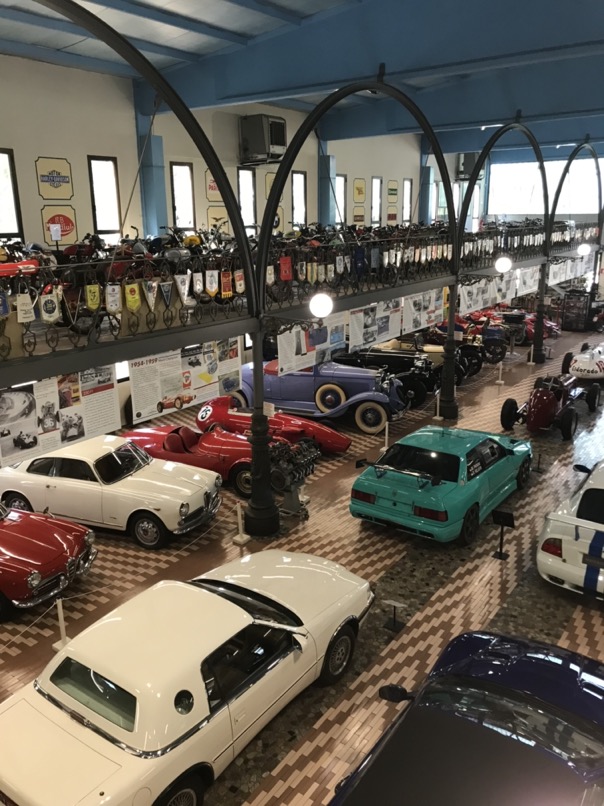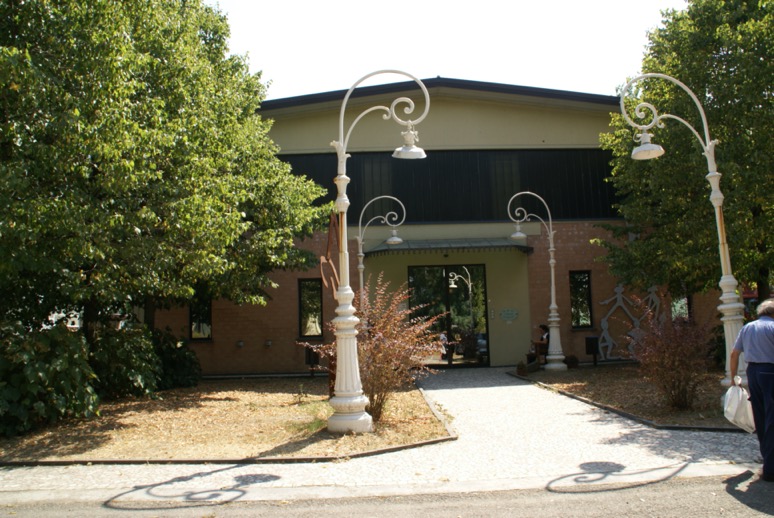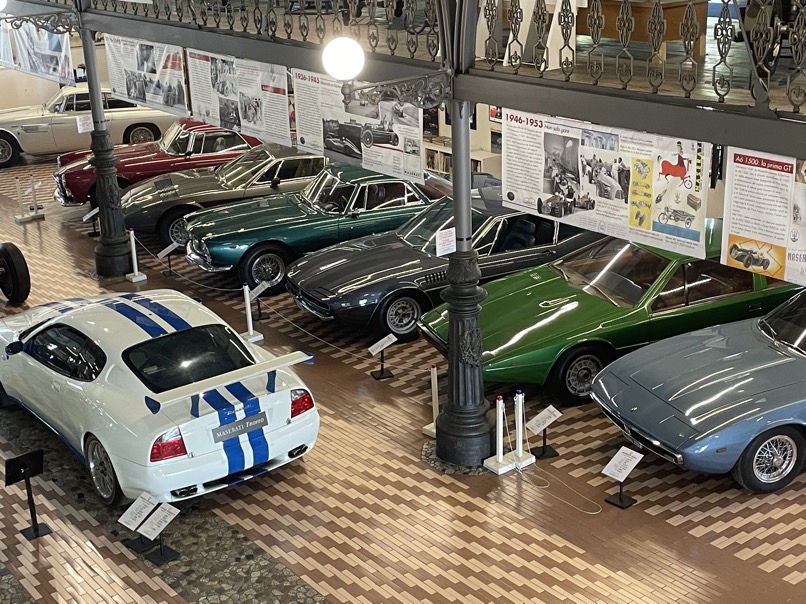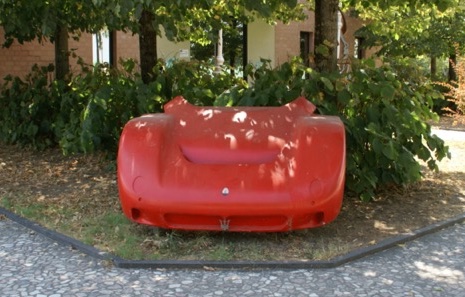


The Umberto Panini Collection
Following the purchase of the Maserati collection, Umberto Panini built a large hall in the middle of his agricultural estate in the style of an early 20th century train station, very airy and supported by metal columns. This hall houses the Maserati collection but also his personal collection of cars and motorcycles. The museum therefore presents about thirty cars, sixty motorcycles, twenty tractors and many objects related to the automobile or the history of Panini. As the agricultural estate has recently been sold, it is possible that the collection will have to move to new premises. There is also talk of opening a Maserati museum in Modena that would combine the Umberto Panini collection and the manufacturer’s contributions. Indeed, Maserati is the only major manufacturer in the region not to have its museum.
The museum, now managed by Giovanni, one of Umberto Panini’s sons, maintains regular relations with the manufacturer. Sometimes the museum lends cars, for example for press meetings or trade shows, while Maserati has entrusted the museum with a few additional cars since the early 2000s. No parking problem since the museum is located in the middle of the agricultural estate, and a large car park is available for visitors. On the side of the museum building, sheltered by an awning, you will find the tractor collection. In front of the building, a model of the front hood decorated with the famous Maserati trident welcomes you.

A few plaques decorate the façade, including one bearing a motto appreciated by Umberto Panini : Do the right thing, and just let it go. We now enter the great hall, and we are immediately seized by the sight of this impressive collection that fills the relatively large building. If the Umberto Panini collection is almost always associated with Maserati, it should not be forgotten that Umberto also collected cars and motorcycles. Indeed, Umberto Panini was passionate about mechanics, and it was he who had designed a machine specific to Panini editions, the Fifimatic which allowed to pack the vignettes in the pockets. In this tour, we will first focus on Maserati before discovering the personal collection of Umberto Panini, and going upstairs to see motorcycles and some other interesting cars.
My Favorites
With many rare, even unique models, the Umberto Panini Collection has no shortage of jewels. Maserati of course, but not only:
- The Maserati A6GCS Berlinetta, beautiful and rare
- The Maserati Bora, one of the most beautiful mid-engine coupes of all time
- The Maserati 420M Eldorado, sponsorship appears in motorsport
- The Alfa Romeo Giulietta duo
The history of Maserati
Founded in 1914, Maserati is the oldest of the major sports car brands in the Modena region. Maserati built its first race car in 1926 with the Tipo 26 which competed in the Grand Prix of the time. Maserati have won many races over the years, the highlight of the list being Juan Manuel Fangio's victory in the 1957 Formula 1 World Championship with the legendary 250F. At the same time, Maserati has also built many sports and grand touring cars. But Maserati has also had a somewhat chaotic history with several changes of ownership as the company has struggled financially. Eventually, Maserati was bought by Fiat from the De Tomaso Group in 1993. Throughout its history, Maserati has been keen to preserve many racing and touring models, creating a true historical heritage. However, this collection, although it remained in the factory after the takeover by Fiat, was not part of the overall deal. In 1996 De Tomaso needing money, asked to take back the collection to sell it. Fiat agreed, keeping only the engines that are now on display in the Maserati showroom in Modena. The cars are shipped to England to be auctioned. Upon hearing this news, the local authorities and the Italian Ministry of Culture went looking for a solution to preserve this heritage and prevent it from being dispersed throughout the world. Umberto Panini was then contacted and he agreed to buy the entire collection which was then repatriated to Modena.
Umberto Panini
Born in 1930, Umberto à Panini moved to Venezuela in 1957 but returned in 1963 to join the family business of Éditions Panini. The Panini company, known worldwide for its sports stickers and collectible albums, is growing rapidly. In 1989, the Panini family decided to sell their company, and Umberto invested in the development of Hombre, a vast estate near Modena to develop a production of Parmigiano-Reggiano, the famous cheese of the region. Umberto Panini wants to make organic cheese of very high quality. The production is therefore done in a closed circuit, the fodder is produced on the land of the farm where the cows are raised that produce the milk with which the cheese is made.
Maserati’s from the Umberto Panini Collection
Maserati has built its reputation in motor racing, and so logically we find in this collection some magnificent examples that raced in the 1930s and 1950s. The 6C/34, powered by a 3.3L inline-6 is derived from the 8C, but is lighter and more powerful. Despite winning several races at the hands of the great Tazio Nuvolari, it struggled to compete in Grand Prix with the powerful Mercedes and Auto-Union. Smaller, the 6CM of 1500cc also raced successfully but in the category “Voiturettes”. The decade from the early 1950s to the early 1960s was one of the most glorious for Maserati.
In the Grands Prix with the A6GCM and especially the Maserati 250F with which Juan Manuel Fangio will be F1 World Champion in 1957. The 250F raced until 1960 in the hands of many famous drivers, Stirling Moss, Alberto Ascari, Luigi Villoresi, Louis Rosier, Peter Collins, Louis Chiron, Jack Brabham, for the official team or many private teams. The 250F also allowed Maria Teresa De Filippis to become the 1st woman to drive in an F1 Grand Prix. The 250F was equipped with the 6-cylinder in-line Maserati and then a V12 that delivered more than 300 horsepower and allowed it to exceed 300 km/h!







Derived from the 250F, the Maserati 420M “Eldorado” was developed for the 1958 Monza 500 Miles, an event that wanted to bring together European and American drivers. Based on the Indianapolis 500 regulations, the 420M is equipped with a 4.2L V8 derived from the 450S engine and adapted to oval banking. Driven by Stirling Moss, it was heavily damaged. It also has the particularity of being in the colors of the ice cream manufacturer Eldorado, the first appearance in motorsport of a sponsor outside the automotive world. It is often simply called Eldorado.






The other legendary Maserati racing machine is the “Birdcage“, officially Tipo 60 (then Tipo 61, 62 and 63), so nicknamed because of its chassis made of a mesh of thin welded aluminum tubes. Initially equipped with an in-line 4-cylinder, the Tipo 63 will receive the V12 of the 250F. The Birdcage has had an honorable sporting career, but it has especially marked the spirits by its original architecture that will be taken up by many manufacturers of racing cars. 2 models are exhibited in the Umberto Panini Collection, a Tipo 61 and a Tipo 63 V12. On the mezzanine is also a Tipo 64 bare frame that makes it possible to understand even more clearly its nickname of Birdcage.



Some A6, A6G or A6GCS racing chassis have also been bodied by coachbuilders (Allemano, Bertone, Frua, Pininfarina, Zagato …) to make road cars, like this A6G/54 bodied by Allemano in elegant 2+2 coupe, or this splendid and rare A6GCS by Pininfarina, only 4 models built.




In 1957, Maserati took the step of real production, with the 3500 GT of 1957, the first Maserati road built in (small) series. Long hood housing the in-house 6-cylinder inline, classic line both elegant and aggressive, the Trident clearly visible in the middle of the grille, the 3500 GT is a success and seduces more than 2000 customers including many stars. The 5000 GT (1964), much rarer (34 copies) takes the chassis of the 3500 GT , this time equipped with a 5L V8.
The Quattroporte sedans of the 1960s also took over the elegant style of the 3500 GT. If Maserati has often shown originality to name its cars, this is not the case of sedans that will keep the name of Quattroporte (4 doors) for several generations, and still today. The 1969 Quattroporte model presented is quite rare, only sixty having been produced with the 4.7L V8.






With the Mistral of 1963, designed by Pietro Frua, the style evolves considerably, much more modern with its fastback line and huge rear bubble. It was the last Maserati to use the 6-cylinder inline, and the first to adopt a wind name as a surname. For many years, the Maserati will be named after winds, or circuits on which the trident firm had shone. The Ghibli (a strong Egyptian wind) is presented in 1966 with its 4.7L V8 developing 330 hp (a 4.9L SS version will be introduced later). The pure line, long hood, 2 seats, truncated rear is the work of Giorgetto Giugiaro. Less sporty than the Ferrari Daytona, less radical than the Lamborghini Miura, it is a very beautiful car, a pure GT, often considered one of the most beautiful Italian of the 1960s. The Ghibli will be available in a magnificent spider, much rarer (only 125 copies), to complete Maserati’s Grand Touring offer.





In 1971, Maserati introduced the Bora, its first mid-engined production car. Still equipped with the 4.7L V8 (it will also be offered with the 4.9L V8), it is also the work of Giorgetto Giugiaro who has since founded Italdesign. Again, this drawing is a masterpiece, elegant and balanced, with just the right amount of aggressiveness. The Bora is for me the most beautiful in its category, and still remains very desirable today. The Khamsin (another hot and violent wind) was presented in 1973 as a successor to the Ghibli. Designed by Marcello Gandini for Bertone, it is a luxurious GT 2+2, still powered by the V8 in 4.9L version of 320 hp. Unfortunately, the oil crisis and the delicate management of Citroën, then owner of Maserati and itself in difficulty, will limit the career of this beautiful car (about 400 produced), but very sought today in collection.






The last representative of this era is the Merak, developed to offer a lighter and less greedy car, able to compete with the Porsche 911, Ferrari 308 or Lamborgini Urraco. It uses the V6 developed for the Citroën SM, increased to 3L of displacement. Also designed by Giugiaro, its lines are inspired by the Bora. Relative success with nearly 2000 cars produced, it was also offered in 2L version to meet Italian tax constraints. However, the Merak presented in the Umberto Panini Collection is a unique model, since it is equipped with a turbo engine intended to test this solution for future models. Finally, the turbo will appear at Maserati on the Biturbo coupe.
The Simun is another unique model. It was a proposal from Giugiaro in 1967 for a more habitable coupe. The project will not be retained, and it is the drawing of Vignale that will give birth to the Indy (one of the few models absent from the collection). However, this Simun was a fully functional and was used by Alejandro de Tomaso as a personal car before he integrated it into the “Maserati fund”. Also the work of Giugiaro, now at the head of his company, the Tipo 124 of 1974 was a proposal to replace the Indy coupe. Not retained, this model has also remained unique.



The 2nd Quattroporte of the Collection is a series III in “Royale” version, more luxurious and better equipped. It is still the famous V8 house that drives this heavy and imposing sedan designed by Giugiaro. Less rare, less desirable too, a Chrysler TC (Touring Convertible) by Maserati was developed and produced by Maserati to Chrysler specifications. The engine is of Chrysler origin, reworked by Maserati. Relatively expensive for its performance, and with an unconvincing style, the Chrysler TC had little commercial success.


Other Maserati not from the initial acquisition joined the Umberto Panini Collection, including 3 competition cars derived from production models: a 1996 Ghibli Open Cup, derived from the Ghibli for racing, a 2003 4200 GT Gransport Trofeo and a 2010 Gran Tourismo Trofeo . The 2014 Gran Cabrio is also a special version, Centenary Edition released for Maserati’s 100th anniversary. From the De Tomaso era also comes the Chubasco (1990), designed by Gandini and which was to give birth to a supercar. But De Tomaso’s finances did not allow development, and the Chubasco remained a pure static study, without engine.





Umberto’s Collection
As has been said, Umberto Panini was passionate about mechanics, and he had built up a small collection of cars according to his favorites. For Umberto, it wasn’t price, brand or prestige that counted, but passion or interest in this or that model. The purchase of the Maserati collection, the construction of the hall to house them and open the Umberto Panini Collection to the public was the opportunity to exhibit his personal collection. If the Maserati are the heart of the museum, there are a dozen interesting cars. A Citroën SM makes the link with the Maserati part, since it was equipped with a V6 developed by the firm with the trident, and which equipped the Merak. Two Alfa Romeo, a Giulietta Sprint coupe and a Giulietta Spider from the 1960s present another aspect of Italian sportiness. With their small 1.3L engine, these light, agile and elegant cars were the delight of lovers of fast driving, and are now highly sought after.





Two Stanguellini illustrate the sporting productions of this small manufacturer from Modena, a Barchetta and a Formula Junior dating from the late 1950s (see the Stanguellini Museum to learn more about this manufacturer). We go back in time again with a Simca Fiat Balila Cabriolet from 1935 and 2 American from the 1930s, a Cadillac Limousine V8, and a Torpedo LaSalle, 2 brands related since LaSalle was just below Cadillac in the GM hierarchy of the time. The oldest of the collection is French, a De Dion Bouton early 20th century, perfectly restored.






Upstairs, 2 small Formula Junior including a Lotus 18 which was the 1st Lotus with rear mid-engine and a great success since 125 units were built. The Lotus 18 was equipped with different engines (BMW, Ford, DKW, Renault…), and driven by the best talents of the time such as Jim Clark. With the engine switched to the rear, the tank was now at the front, just in front of the pilot. Probably not the safest solution! Very versatile, it was also used in F2 and F1!
The Motorcycles of Umberto Panini
Even more than cars, Umberto was passionate about motorcycles. It brought together about sixty 2-wheelers, motorcycles and scooters. Most are grouped on one side of the mezzanine, but a few others are also exposed near cars, on the ground floor and upstairs. The Maserati are precisely on the ground floor, because Maserati actually produced motorcycles in the 1950s, when Adolfo Orsi was the owner of the brand. Very varied, the Collection covers a good part of the 20th century, with the first motorized bicycles of the beginning, road or racing machines, scooters and sidecars. If Italian brands are well represented with Ducati, Gilera, Laverda, Moto Guzzi, there are also BMW, BSA, Harley Davidson, Indian, Norton or Triumph and many other brands that have disappeared or with more ephemeral productions.




Among the curiosities, a comfortable tricycle, a Harley Davidson sidecar and a 3-wheeled Servicar of the same brand, a rare Laverda 750 SFC, customer competition model produced at about 500 units, a DKW Wankel, also rare (production from 1974 to 1977), one of the only motorcycles to have used the Wankel rotary engine. A unique machine, the Lambretta 125 Streamline is a fully streamlined scooter, which broke many speed records in Montlhéry in 1951, including the one on the kilometer launched 201km / h! This record will stand for twenty years!





Engines
As previously stated, the engine collection of the Maserati fund has been kept by the manufacturer, but the Umberto Panini Collection features several Maserati engines, with one example of the legendary 6-cylinder inline that has powered several generations of cars, in racing and on the road. The model on display equipped the 3500 GT. The V12 that powers the Maserati MC12 supercar (2004) is derived from the block of the Ferrari Enzo, while the 2L V6 Biturbo equipping the eponymous model in the early 1980s is the first production engine (in the world) to use 2 turbos. The engine collection is completed by a Ferrari V12, and a much smaller 125cc single-cylinder Maserati motorcycle.



Decoration and tractors
Posters, photos and posters, car accessories, old oil and petrol pumps, as well as some Panini machines create the decor of the museum. The history of Maserati from 1914 to 2014 is also told by a series of posters hanging from the mezzanine posts. It includes the major stages of the company, both in racing and production, major figures and legendary models. Finally, as mentioned above, the Umberto Panini Collection presents under a canopy along the hall a panoply of old tractors. Most are in their juice while a few have been restored and repainted, with an interesting choice among the twenty models presented, such as this Lamborghini 2241. Several very old models are equipped with metal wheels (without tires), such as this antique Fiat or this Balilla from 1929.




Conclusion
The Umberto Panini Collection is a jewel not to be missed in the Modena region with its rare models, even unique for many. It compensates for the absence of an official Maserati museum, but also offers other very beautiful pieces apart from the jewels of the manufacturer with the trident.
The photos on this page belong to Automobile-Museums, no use or reproduction is allowed without the prior written consent of the owner.
